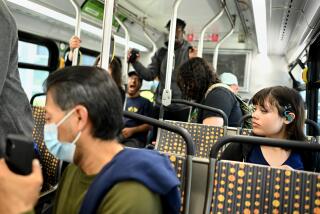U.S. Study Urges Programs to Address Isolation Felt by Non-Driving Seniors
- Share via
Shirley Goldstein remembers wistfully the days when she still had a car.
Since the 81-year-old Sherman Oaks resident stopped driving six years ago, she doesn’t see her friends as much. She now spends most of her evenings at home, instead of at the cinema or church bingo games.
“My friends ... we’re all in our late 70s and 80s. We don’t drive. It’s hard for us to get anywhere,” Goldstein said. “Now, we’re mostly stay-at-home folks.”
Millions of older Americans like Goldstein suffer from limited mobility because they do not drive. The resulting isolation affects not only their psychological well-being but possibly their health, according to a national study released Tuesday.
Across the nation, 54% of non-drivers age 65 and older stay home on a given day, while only 17% of driving seniors do the same, according to a report by the Surface Transportation Policy Project, a Washington-based nonprofit group.
While some might be homebound for health reasons, others are just stuck. Seniors without cars make 59% fewer shopping and restaurant trips and are 65% less likely to go out socially or attend religious service. Compared with their driving peers, car-less seniors are 15% less likely to see a doctor, according to the report.
The study blames sprawl and the lack of alternatives for the non-drivers’ isolation.
In the Los Angeles, Riverside and Orange counties metropolitan region, where the car is king, 53% of seniors who do not drive stay home on any given day, compared with 48% in the transit-plentiful and more pedestrian-friendly New York City area.
“This will challenge us in the transportation business to think about where to put our money,” said Anne Canby, president of the Surface Transportation Policy Project, at a telephone news conference Tuesday. She called on Congress, now hammering out competing House and Senate transportation-funding bills, “to address the mobility needs ... of our growing older population.”
With so many baby boomers turning gray, America is becoming a society of seniors. The number of those 65 and older is projected to increase from about 35 million today to 87 million by 2050, according to demographers.
The study, which analyzed federal data collected in 2001 but made available to researchers this year, recommends greater funding for public transit and sidewalk improvements to encourage more seniors to walk.
The report also urges more programs targeting seniors’ special needs.
More to Read
Sign up for Essential California
The most important California stories and recommendations in your inbox every morning.
You may occasionally receive promotional content from the Los Angeles Times.













